Abstract
This article reviews the available data on the carcinogenicity of formaldehyde from experimental and epidemiologic studies and makes recommendations for further research. Two definitive chronic inhalation bioassays on rodents have demonstrated that formaldehyde produces nasal cancer in rats and mice at 14 ppm and in rats at 6 ppm, which is within the domain of present permissible human exposure (8-hr time-weighted average of 3 ppm, a 5 ppm ceiling, and a 10 ppm short-term exposure limit). Biochemical and physiologic studies in rats have shown that inhaled formaldehyde can depress respiration, inhibit mucociliary clearance, stimulate cell proliferation, and crosslink DNA and protein in the nasal mucosa. No deaths from nasal cancer have been reported in epidemiologic studies of cohorts exposed to formaldehyde, but three case-control studies suggest the possibility of increased risk. Although excesses of lung cancer deaths have been observed in some studies at industrial plants with formaldehyde exposure, uncertainties in interpretation limit the evaluation of these findings. Excess cancers of the brain and of lymphatic and hematopoietic tissues have been reported in certain studies of industrial groups and in most studies of formaldehyde-exposed professionals, but whether these excesses are related to formaldehyde exposure is not known. Several properties of formaldehyde pose unique problems for future research: the mechanisms responsible for its nonlinear response; its probable mechanism of carcinogenic action as a cross-linking agent; its formation in tissues as a normal metabolite; its possible action as a promoter and/or a cocarcinogen; and the importance of glutathione as a host defense at low exposure.
Full text
PDF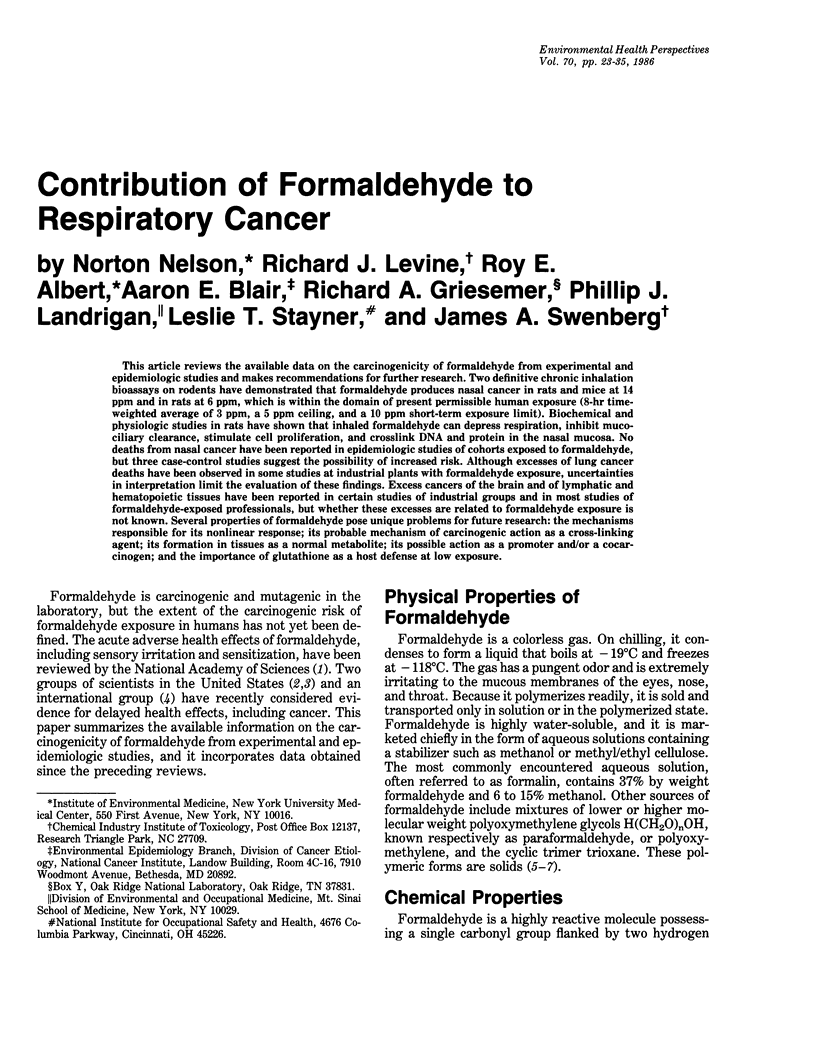
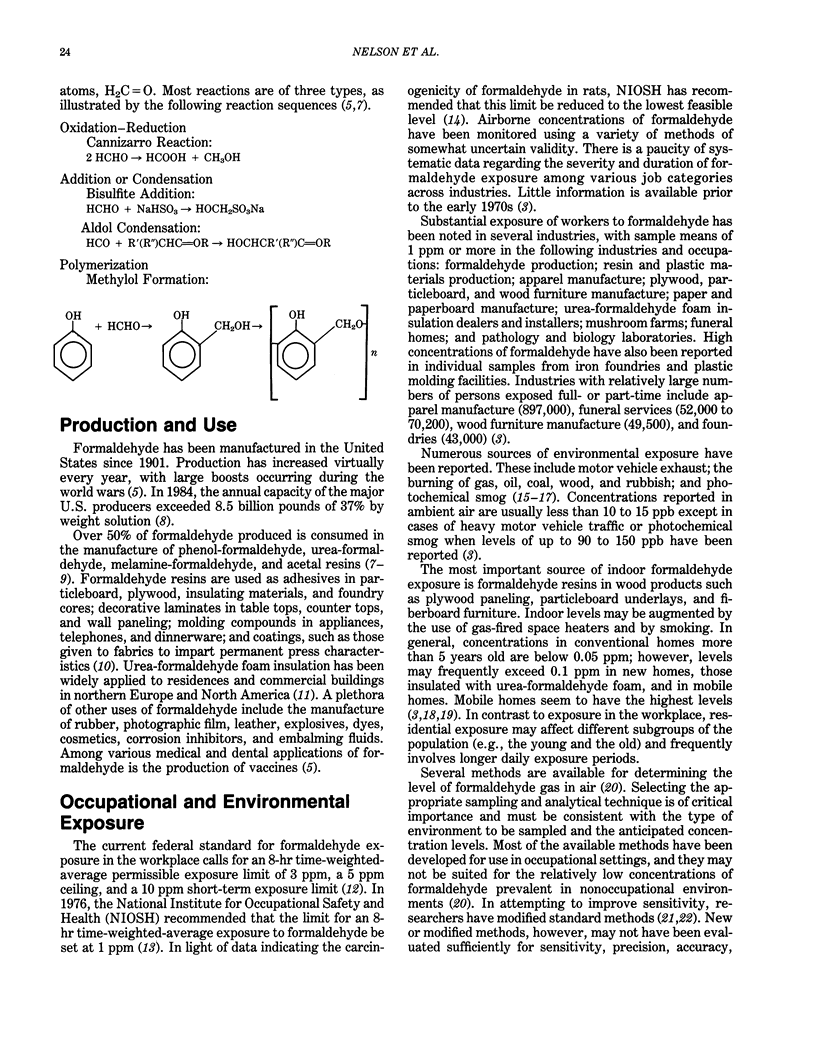
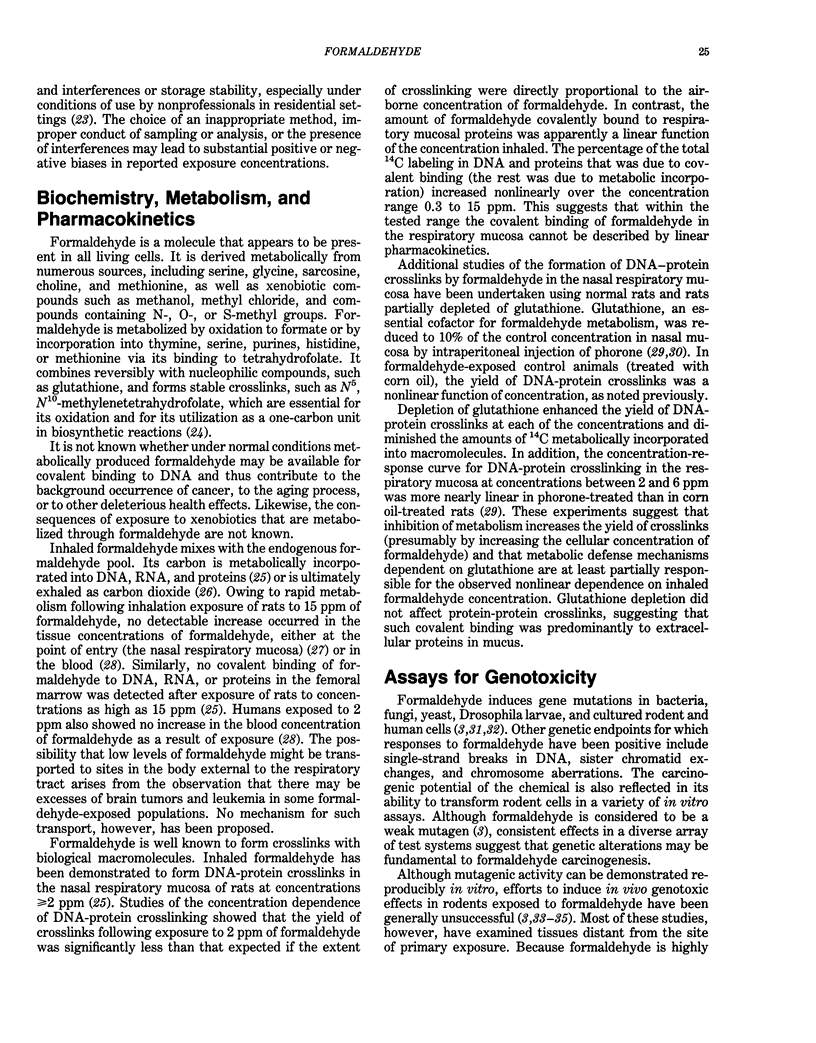
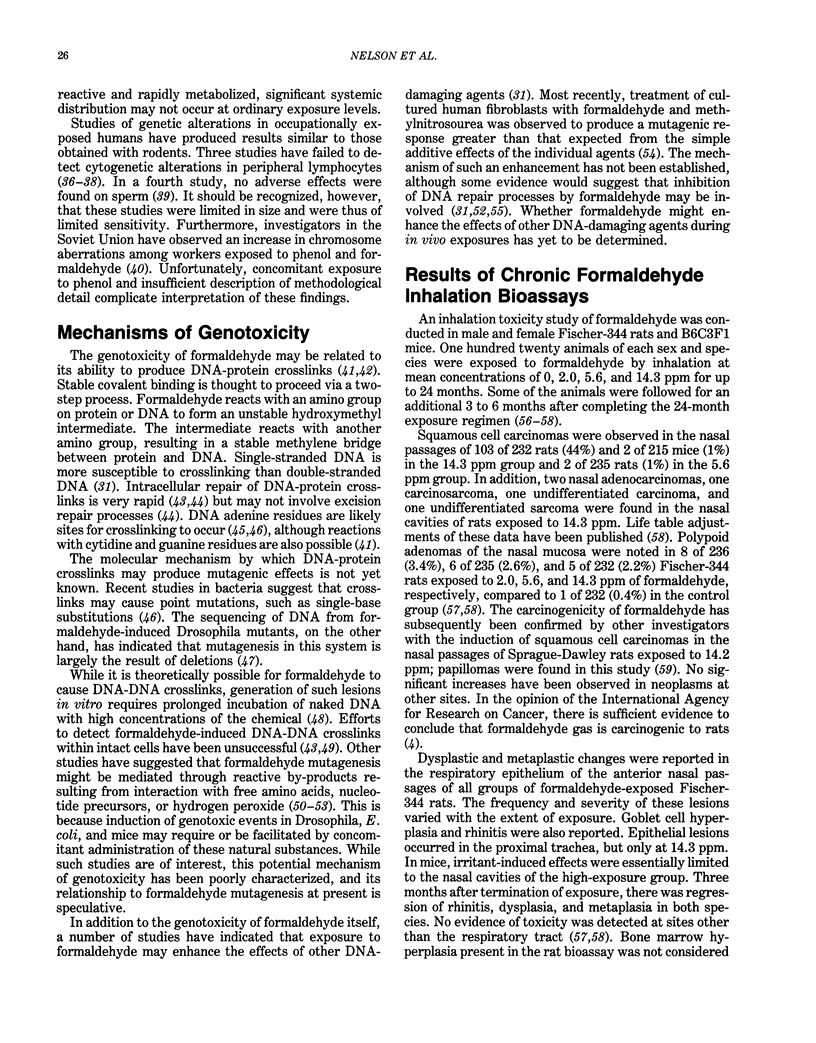
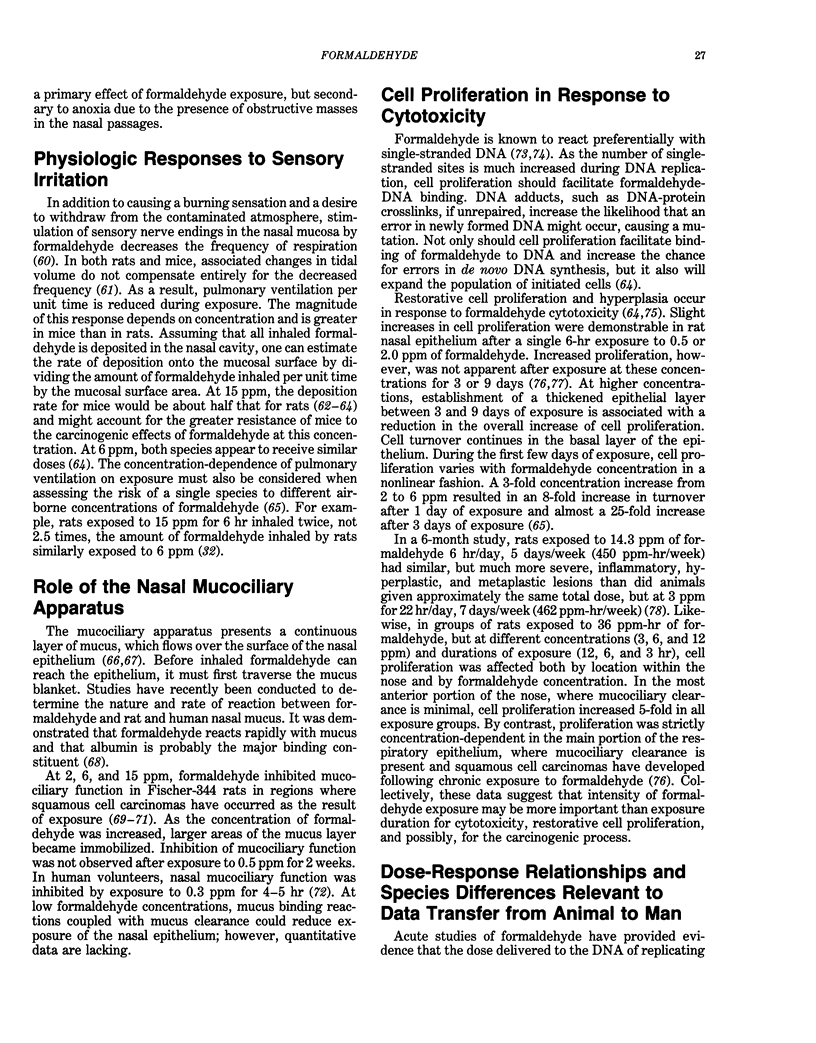

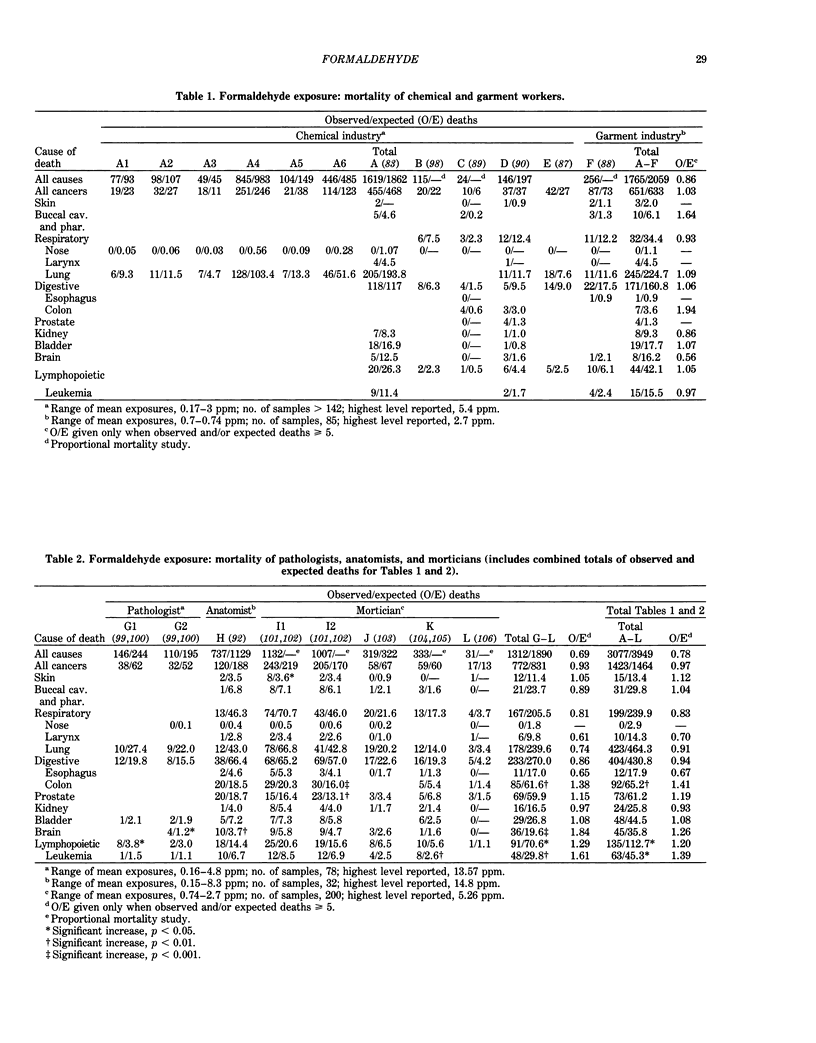
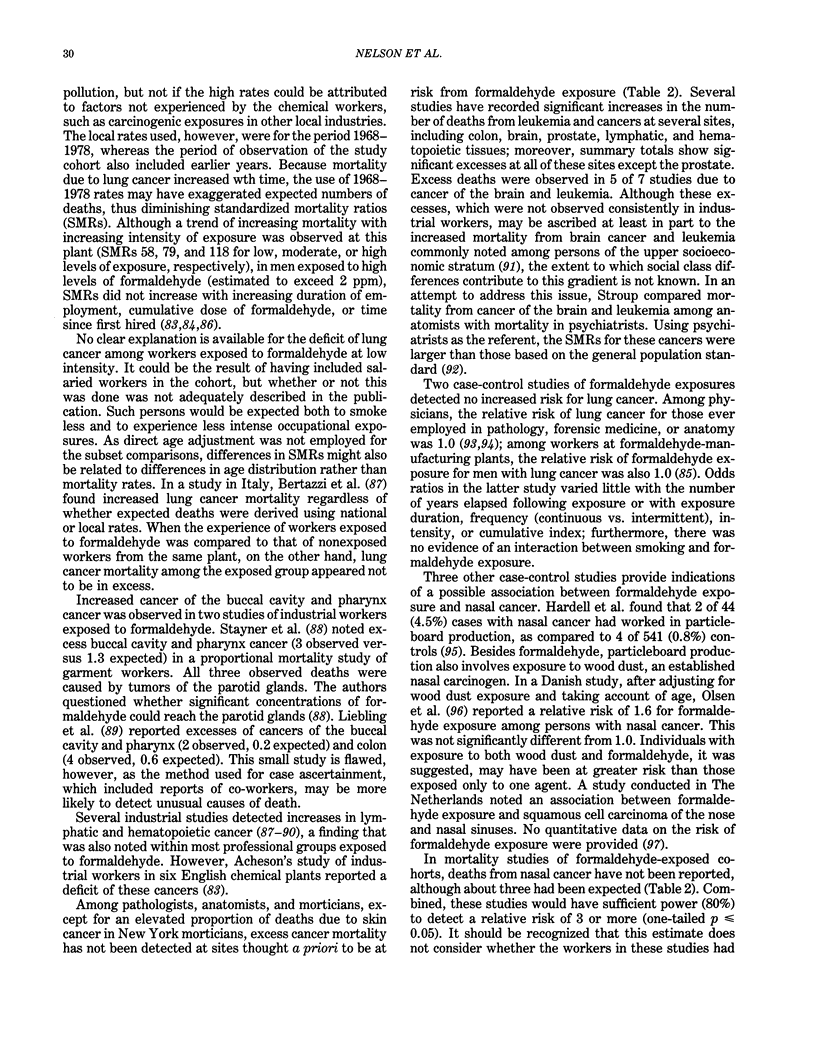

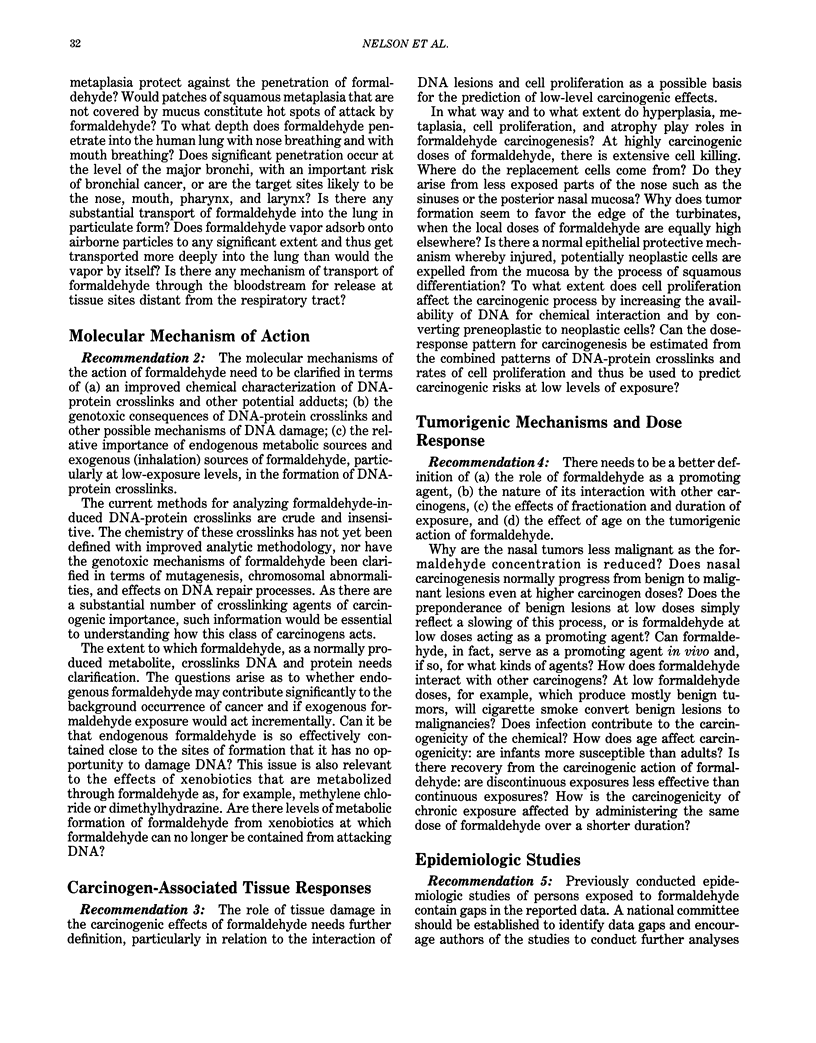
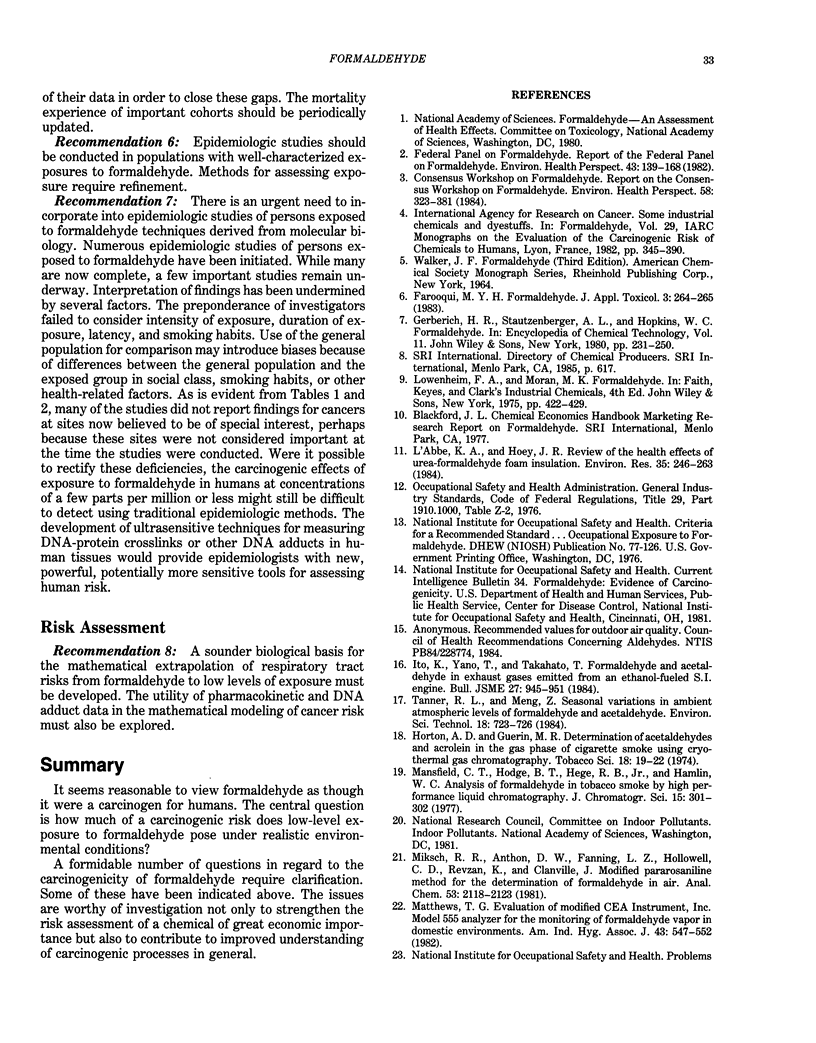
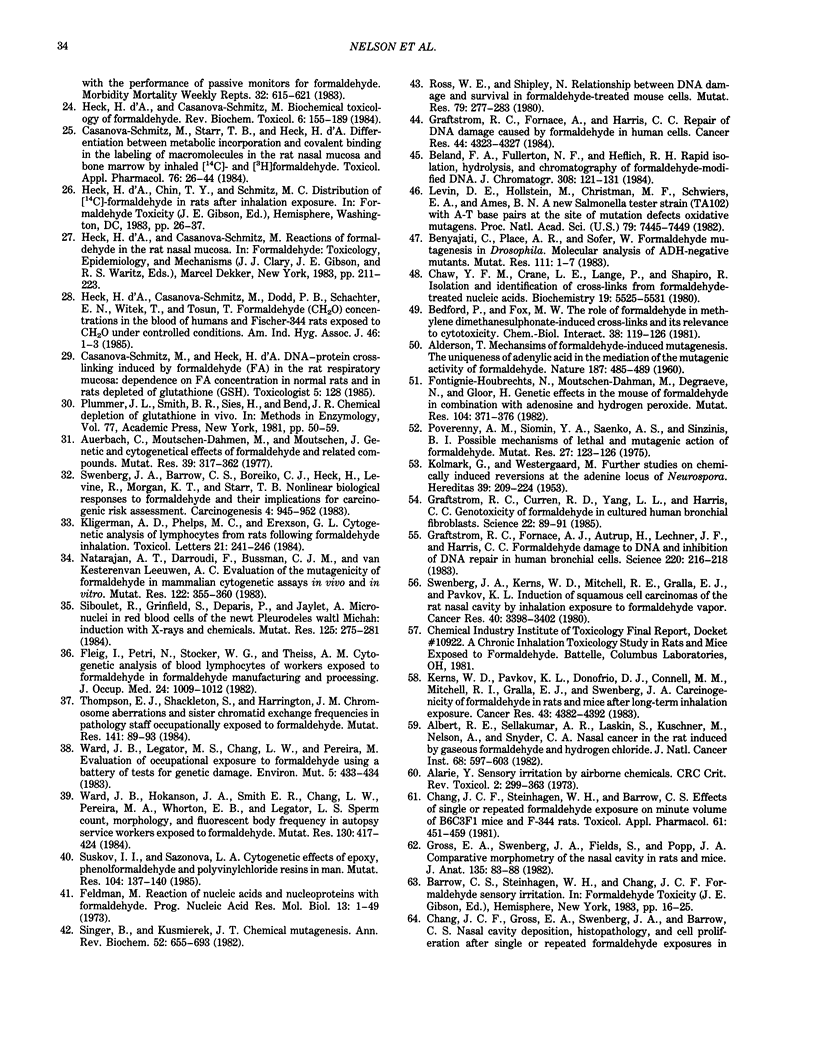
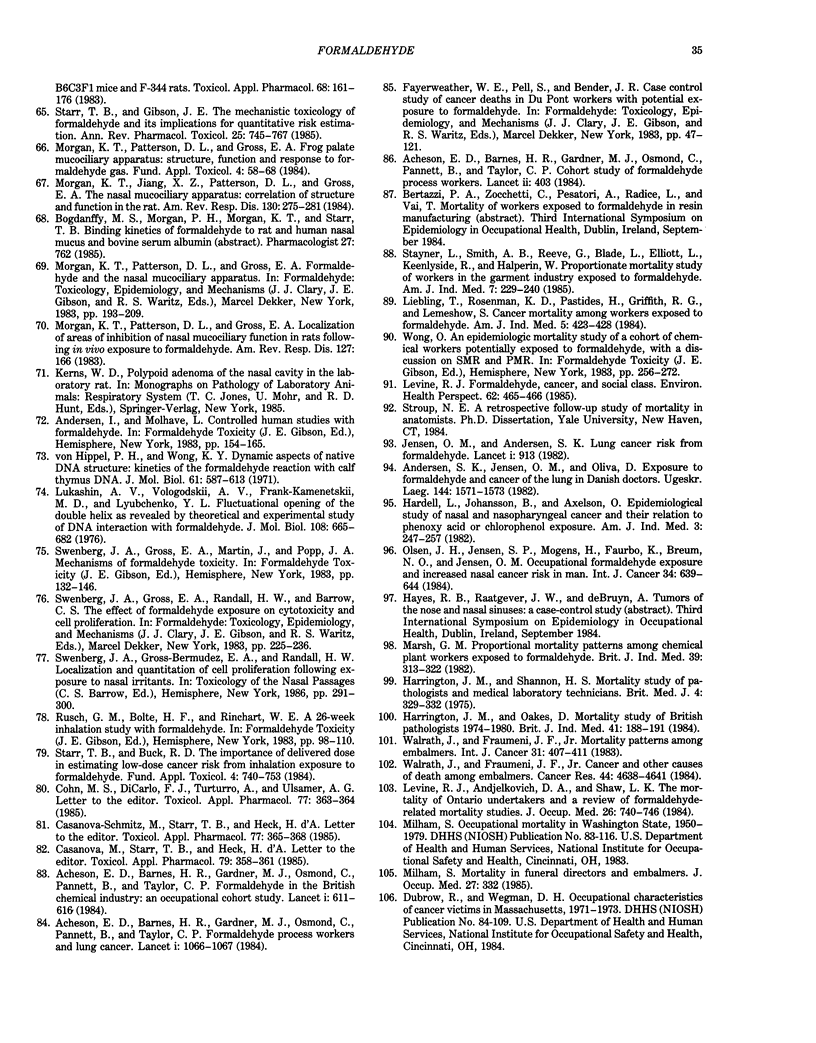
Selected References
These references are in PubMed. This may not be the complete list of references from this article.
- ALDERSON T. Mechanism of formaldehyde-induced mutagenesis. The uniqueness of adenylic acid in the mediation of the mutagenic activity of formaldehyde. Nature. 1960 Aug 6;187:485–489. doi: 10.1038/187485a0. [DOI] [PubMed] [Google Scholar]
- Acheson E. D., Barnes H. R., Gardner M. J., Osmond C., Pannett B., Taylor C. P. Cohort study of formaldehyde process workers. Lancet. 1984 Aug 18;2(8399):403–403. doi: 10.1016/s0140-6736(84)90568-3. [DOI] [PubMed] [Google Scholar]
- Acheson E. D., Barnes H. R., Gardner M. J., Osmond C., Pannett B., Taylor C. P. Formaldehyde process workers and lung cancer. Lancet. 1984 May 12;1(8385):1066–1067. doi: 10.1016/s0140-6736(84)91466-1. [DOI] [PubMed] [Google Scholar]
- Alarie Y. Sensory irritation by airborne chemicals. CRC Crit Rev Toxicol. 1973 Nov;2(3):299–363. doi: 10.3109/10408447309082020. [DOI] [PubMed] [Google Scholar]
- Albert R. E., Sellakumar A. R., Laskin S., Kuschner M., Nelson N., Snyder C. A. Gaseous formaldehyde and hydrogen chloride induction of nasal cancer in the rat. J Natl Cancer Inst. 1982 Apr;68(4):597–603. [PubMed] [Google Scholar]
- Andersen S. K., Jensen O. M., Oliva D. Formaldehydeksponering og lungecancer blandt danske laeger. Ugeskr Laeger. 1982 May 24;144(21):1571–1573. [PubMed] [Google Scholar]
- Auerbach C., Moutschen-Dahmen M., Moutschen J. Genetic and cytogenetical effects of formaldehyde and related compounds. Mutat Res. 1977;39(3-4):317–361. doi: 10.1016/0165-1110(77)90011-2. [DOI] [PubMed] [Google Scholar]
- Bedford P., Fox B. W. The role of formaldehyde in methylene dimethanesulphonate-induced DNA cross-links and its relevance to cytotoxicity. Chem Biol Interact. 1981 Dec;38(1):119–128. doi: 10.1016/0009-2797(81)90158-7. [DOI] [PubMed] [Google Scholar]
- Beland F. A., Fullerton N. F., Heflich R. H. Rapid isolation, hydrolysis and chromatography of formaldehyde-modified DNA. J Chromatogr. 1984 Jun 8;308:121–131. doi: 10.1016/s0021-9673(01)87539-7. [DOI] [PubMed] [Google Scholar]
- Casanova-Schmitz M., Starr T. B., Heck H. D. Differentiation between metabolic incorporation and covalent binding in the labeling of macromolecules in the rat nasal mucosa and bone marrow by inhaled [14C]- and [3H]formaldehyde. Toxicol Appl Pharmacol. 1984 Oct;76(1):26–44. doi: 10.1016/0041-008x(84)90026-7. [DOI] [PubMed] [Google Scholar]
- Chang J. C., Gross E. A., Swenberg J. A., Barrow C. S. Nasal cavity deposition, histopathology, and cell proliferation after single or repeated formaldehyde exposures in B6C3F1 mice and F-344 rats. Toxicol Appl Pharmacol. 1983 Apr;68(2):161–176. doi: 10.1016/0041-008x(83)90001-7. [DOI] [PubMed] [Google Scholar]
- Chang J. C., Steinhagen W. H., Barrow C. S. Effect of single or repeated formaldehyde exposure on minute volume of B6C3F1 mice and F-344 rats. Toxicol Appl Pharmacol. 1981 Dec;61(3):451–459. doi: 10.1016/0041-008x(81)90368-9. [DOI] [PubMed] [Google Scholar]
- Chaw Y. F., Crane L. E., Lange P., Shapiro R. Isolation and identification of cross-links from formaldehyde-treated nucleic acids. Biochemistry. 1980 Nov 25;19(24):5525–5531. doi: 10.1021/bi00565a010. [DOI] [PubMed] [Google Scholar]
- Cohn M. S., DiCarlo F. J., Turturro A., Ulsamer A. G. Nonlinear association between covalent binding of formaldehyde to DNA and administered formaldehyde concentration. Toxicol Appl Pharmacol. 1985 Feb;77(2):363–368. doi: 10.1016/0041-008x(85)90337-0. [DOI] [PubMed] [Google Scholar]
- Farooqui M. Y. Formaldehyde. J Appl Toxicol. 1983 Oct;3(5):264–265. doi: 10.1002/jat.2550030510. [DOI] [PubMed] [Google Scholar]
- Feldman M. Y. Reactions of nucleic acids and nucleoproteins with formaldehyde. Prog Nucleic Acid Res Mol Biol. 1973;13:1–49. doi: 10.1016/s0079-6603(08)60099-9. [DOI] [PubMed] [Google Scholar]
- Fleig I., Petri N., Stocker W. G., Thiess A. M. Cytogenetic analyses of blood lymphocytes of workers exposed to formaldehyde in formaldehyde manufacturing and processing. J Occup Med. 1982 Dec;24(12):1009–1012. [PubMed] [Google Scholar]
- Fontignie-Houbrechts N., Moutschen-Dahmen M., Degraeve N., Gloor H. Genetic effects in the mouse of formaldehyde in combination with adenosine and hydrogen peroxide. Mutat Res. 1982 Jul;104(6):371–376. doi: 10.1016/0165-7992(82)90172-5. [DOI] [PubMed] [Google Scholar]
- Grafstrom R. C., Fornace A. J., Jr, Autrup H., Lechner J. F., Harris C. C. Formaldehyde damage to DNA and inhibition of DNA repair in human bronchial cells. Science. 1983 Apr 8;220(4593):216–218. doi: 10.1126/science.6828890. [DOI] [PubMed] [Google Scholar]
- Grafstrom R. C., Fornace A., Jr, Harris C. C. Repair of DNA damage caused by formaldehyde in human cells. Cancer Res. 1984 Oct;44(10):4323–4327. [PubMed] [Google Scholar]
- Gross E. A., Swenberg J. A., Fields S., Popp J. A. Comparative morphometry of the nasal cavity in rats and mice. J Anat. 1982 Aug;135(Pt 1):83–88. [PMC free article] [PubMed] [Google Scholar]
- Hardell L., Johansson B., Axelson O. Epidemiological study of nasal and nasopharyngeal cancer and their relation to phenoxy acid or chlorophenol exposure. Am J Ind Med. 1982;3(3):247–257. doi: 10.1002/ajim.4700030304. [DOI] [PubMed] [Google Scholar]
- Harrington J. M., Oakes D. Mortality study of British pathologists 1974-80. Br J Ind Med. 1984 May;41(2):188–191. doi: 10.1136/oem.41.2.188. [DOI] [PMC free article] [PubMed] [Google Scholar]
- Harrington J. M., Shannon H. S. Mortality study of pathologists and medical laboratory technicians. Br Med J. 1975 Nov 8;4(5992):329–332. doi: 10.1136/bmj.4.5992.329. [DOI] [PMC free article] [PubMed] [Google Scholar]
- Jensen O. M., Andersen S. K. Lung cancer risk from formaldehyde. Lancet. 1982 Apr 17;1(8277):913–913. doi: 10.1016/s0140-6736(82)92185-7. [DOI] [PubMed] [Google Scholar]
- Kerns W. D., Pavkov K. L., Donofrio D. J., Gralla E. J., Swenberg J. A. Carcinogenicity of formaldehyde in rats and mice after long-term inhalation exposure. Cancer Res. 1983 Sep;43(9):4382–4392. [PubMed] [Google Scholar]
- Kligerman A. D., Phelps M. C., Erexson G. L. Cytogenetic analysis of lymphocytes from rats following formaldehyde inhalation. Toxicol Lett. 1984 Jun;21(3):241–246. doi: 10.1016/0378-4274(84)90079-1. [DOI] [PubMed] [Google Scholar]
- L'Abbé K. A., Hoey J. R. Review of the health effects of urea-formaldehyde foam insulation. Environ Res. 1984 Oct;35(1):246–263. doi: 10.1016/0013-9351(84)90133-6. [DOI] [PubMed] [Google Scholar]
- Levin D. E., Hollstein M., Christman M. F., Schwiers E. A., Ames B. N. A new Salmonella tester strain (TA102) with A X T base pairs at the site of mutation detects oxidative mutagens. Proc Natl Acad Sci U S A. 1982 Dec;79(23):7445–7449. doi: 10.1073/pnas.79.23.7445. [DOI] [PMC free article] [PubMed] [Google Scholar]
- Levine R. J., Andjelkovich D. A., Shaw L. K. The mortality of Ontario undertakers and a review of formaldehyde-related mortality studies. J Occup Med. 1984 Oct;26(10):740–746. doi: 10.1097/00043764-198410000-00014. [DOI] [PubMed] [Google Scholar]
- Levine R. J. Formaldehyde, cancer, and social class. Environ Health Perspect. 1985 Oct;62:465–466. doi: 10.1289/ehp.8562465. [DOI] [PMC free article] [PubMed] [Google Scholar]
- Liebling T., Rosenman K. D., Pastides H., Griffith R. G., Lemeshow S. Cancer mortality among workers exposed to formaldehyde. Am J Ind Med. 1984;5(6):423–428. doi: 10.1002/ajim.4700050602. [DOI] [PubMed] [Google Scholar]
- Lukashin A. V., Vologodskii A. V., Frank-Kamenetskii M. D., Lyubchenko Y. L. Fluctuational opening of the double helix as revealed by theoretical and experimental study of DNA interaction with formaldehyde. J Mol Biol. 1976 Dec 25;108(4):665–682. doi: 10.1016/s0022-2836(76)80111-8. [DOI] [PubMed] [Google Scholar]
- Mansell A. L., Levison H., Bailey J. D. Maturation of lung function in children with hypopituitarism. Am Rev Respir Dis. 1983 Feb;127(2):166–170. doi: 10.1164/arrd.1983.127.2.166. [DOI] [PubMed] [Google Scholar]
- Mansfield C. T., Hodge B. T., Hege R. B., Jr, Hamlin W. C. Analysis of formaldehyde in tobacco smoke by high performance liquid chromatography. J Chromatogr Sci. 1977 Aug;15(8):301–302. doi: 10.1093/chromsci/15.8.301. [DOI] [PubMed] [Google Scholar]
- Marsh G. M. Proportional mortality patterns among chemical plant workers exposed to formaldehyde. Br J Ind Med. 1982 Nov;39(4):313–322. doi: 10.1136/oem.39.4.313. [DOI] [PMC free article] [PubMed] [Google Scholar]
- Morgan K. T., Jiang X. Z., Patterson D. L., Gross E. A. The nasal mucociliary apparatus. Correlation of structure and function in the rat. Am Rev Respir Dis. 1984 Aug;130(2):275–281. doi: 10.1164/arrd.1984.130.2.275. [DOI] [PubMed] [Google Scholar]
- Morgan K. T., Patterson D. L., Gross E. A. Frog palate mucociliary apparatus: structure, function, and response to formaldehyde gas. Fundam Appl Toxicol. 1984 Feb;4(1):58–68. doi: 10.1016/0272-0590(84)90219-7. [DOI] [PubMed] [Google Scholar]
- Natarajan A. T., Darroudi F., Bussman C. J., van Kesteren-van Leeuwen A. C. Evaluation of the mutagenicity of formaldehyde in mammalian cytogenetic assays in vivo and vitro. Mutat Res. 1983 Dec;122(3-4):355–360. doi: 10.1016/0165-7992(83)90019-2. [DOI] [PubMed] [Google Scholar]
- Olsen J. H., Jensen S. P., Hink M., Faurbo K., Breum N. O., Jensen O. M. Occupational formaldehyde exposure and increased nasal cancer risk in man. Int J Cancer. 1984 Nov 15;34(5):639–644. doi: 10.1002/ijc.2910340509. [DOI] [PubMed] [Google Scholar]
- Plummer J. L., Smith B. R., Sies H., Bend J. R. Chemical depletion of glutathione in vivo. Methods Enzymol. 1981;77:50–59. doi: 10.1016/s0076-6879(81)77010-1. [DOI] [PubMed] [Google Scholar]
- Poverenny A. M., Siomin Y. A., Saenko A. S., Sinzinis B. I. Possible mechanisms of lethal and mutagenic action of formaldehyde. Mutat Res. 1975 Jan;27(1):123–126. doi: 10.1016/0027-5107(75)90280-8. [DOI] [PubMed] [Google Scholar]
- Ross W. E., Shipley N. Relationship between DNA damage and survival in formaldehyde-treated mouse cells. Mutat Res. 1980 Nov;79(3):277–283. doi: 10.1016/0165-1218(80)90075-0. [DOI] [PubMed] [Google Scholar]
- Siboulet R., Grinfeld S., Deparis P., Jaylet A. Micronuclei in red blood cells of the newt Pleurodeles waltl Michah: induction with X-rays and chemicals. Mutat Res. 1984 Feb;125(2):275–281. doi: 10.1016/0027-5107(84)90077-0. [DOI] [PubMed] [Google Scholar]
- Starr T. B., Buck R. D. The importance of delivered dose in estimating low-dose cancer risk from inhalation exposure to formaldehyde. Fundam Appl Toxicol. 1984 Oct;4(5):740–753. doi: 10.1016/0272-0590(84)90095-2. [DOI] [PubMed] [Google Scholar]
- Starr T. B., Gibson J. E. The mechanistic toxicology of formaldehyde and its implications for quantitative risk estimation. Annu Rev Pharmacol Toxicol. 1985;25:745–767. doi: 10.1146/annurev.pa.25.040185.003525. [DOI] [PubMed] [Google Scholar]
- Suskov I. I., Sazonova L. A. Cytogenetic effects of epoxy, phenolformaldehyde and polyvinylchloride resins in man. Mutat Res. 1982 Apr;104(1-3):137–140. doi: 10.1016/0165-7992(82)90134-8. [DOI] [PubMed] [Google Scholar]
- Swenberg J. A., Barrow C. S., Boreiko C. J., Heck H. D., Levine R. J., Morgan K. T., Starr T. B. Non-linear biological responses to formaldehyde and their implications for carcinogenic risk assessment. Carcinogenesis. 1983 Aug;4(8):945–952. doi: 10.1093/carcin/4.8.945. [DOI] [PubMed] [Google Scholar]
- Swenberg J. A., Kerns W. D., Mitchell R. I., Gralla E. J., Pavkov K. L. Induction of squamous cell carcinomas of the rat nasal cavity by inhalation exposure to formaldehyde vapor. Cancer Res. 1980 Sep;40(9):3398–3402. [PubMed] [Google Scholar]
- Thomson E. J., Shackleton S., Harrington J. M. Chromosome aberrations and sister-chromatid exchange frequencies in pathology staff occupationally exposed to formaldehyde. Mutat Res. 1984 Oct;141(2):89–93. doi: 10.1016/0165-7992(84)90016-2. [DOI] [PubMed] [Google Scholar]
- Von Hippel P. H., Wong K. Y. Dynamic aspects of native DNA structure: kinetics of the formaldehyde reaction with calf thymus DNA. J Mol Biol. 1971 Nov 14;61(3):587–613. doi: 10.1016/0022-2836(71)90066-0. [DOI] [PubMed] [Google Scholar]
- Walrath J., Fraumeni J. F., Jr Cancer and other causes of death among embalmers. Cancer Res. 1984 Oct;44(10):4638–4641. [PubMed] [Google Scholar]
- Walrath J., Fraumeni J. F., Jr Mortality patterns among embalmers. Int J Cancer. 1983 Apr 15;31(4):407–411. doi: 10.1002/ijc.2910310403. [DOI] [PubMed] [Google Scholar]
- Ward J. B., Jr, Hokanson J. A., Smith E. R., Chang L. W., Pereira M. A., Whorton E. B., Jr, Legator M. S. Sperm count, morphology and fluorescent body frequency in autopsy service workers exposed to formaldehyde. Mutat Res. 1984 Dec;130(6):417–424. doi: 10.1016/0165-1161(84)90014-1. [DOI] [PubMed] [Google Scholar]


